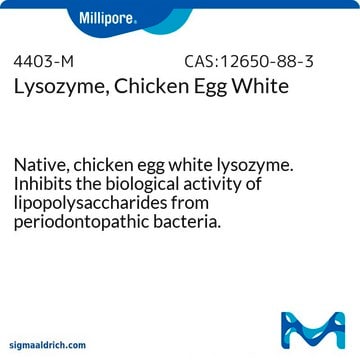M3770
Micrococcus lysodeikticus ATCC No. 4698
suitable for substrate for the assay of lysozyme, lyophilized cells
Synonym(s):
Micrococcus luetus
About This Item
Recommended Products
form
lyophilized cells
Quality Level
suitability
suitable for substrate for the assay of lysozyme
storage temp.
−20°C
Application
Biochem/physiol Actions
Quality
Unit Definition
Storage Class Code
11 - Combustible Solids
WGK
WGK 3
Flash Point(F)
Not applicable
Flash Point(C)
Not applicable
Personal Protective Equipment
Certificates of Analysis (COA)
Search for Certificates of Analysis (COA) by entering the products Lot/Batch Number. Lot and Batch Numbers can be found on a product’s label following the words ‘Lot’ or ‘Batch’.
Already Own This Product?
Find documentation for the products that you have recently purchased in the Document Library.
Customers Also Viewed
Protocols
To measure achromopeptidase activity, this procedure uses bacterial cells and a turbidimetric rate assay. Turbidity is measured at 600 nm using a spectrophotometer.
To measure achromopeptidase activity, this procedure uses bacterial cells and a turbidimetric rate assay. Turbidity is measured at 600 nm using a spectrophotometer.
To measure achromopeptidase activity, this procedure uses bacterial cells and a turbidimetric rate assay. Turbidity is measured at 600 nm using a spectrophotometer.
To measure achromopeptidase activity, this procedure uses bacterial cells and a turbidimetric rate assay. Turbidity is measured at 600 nm using a spectrophotometer.
Our team of scientists has experience in all areas of research including Life Science, Material Science, Chemical Synthesis, Chromatography, Analytical and many others.
Contact Technical Service







